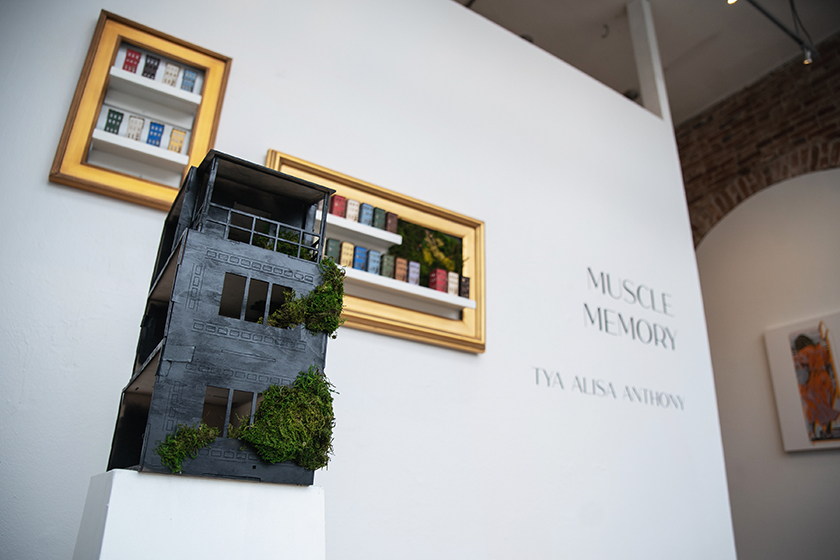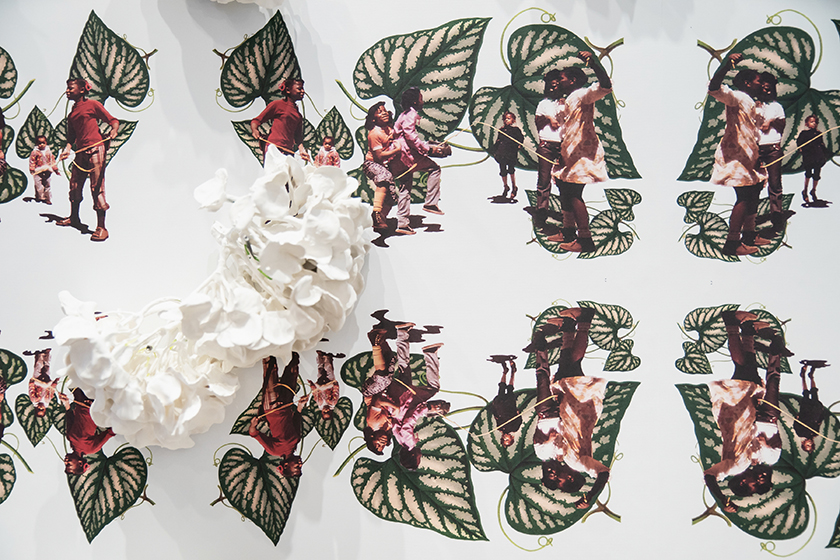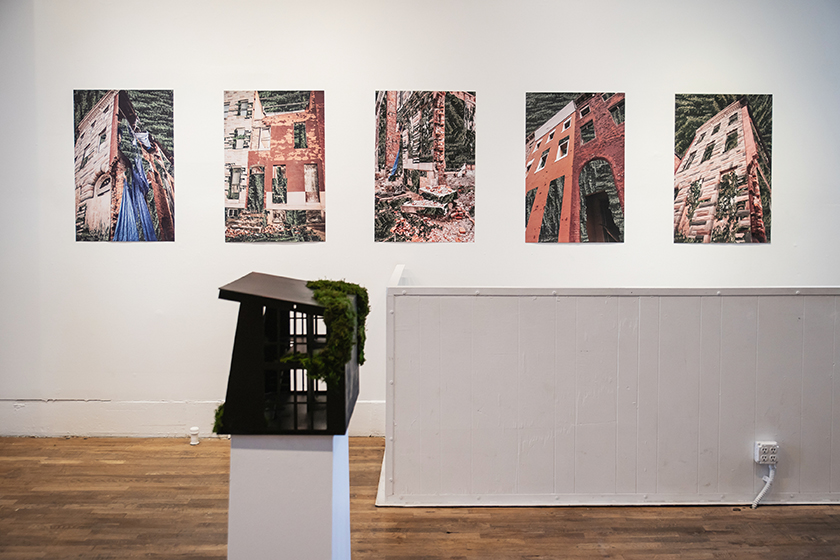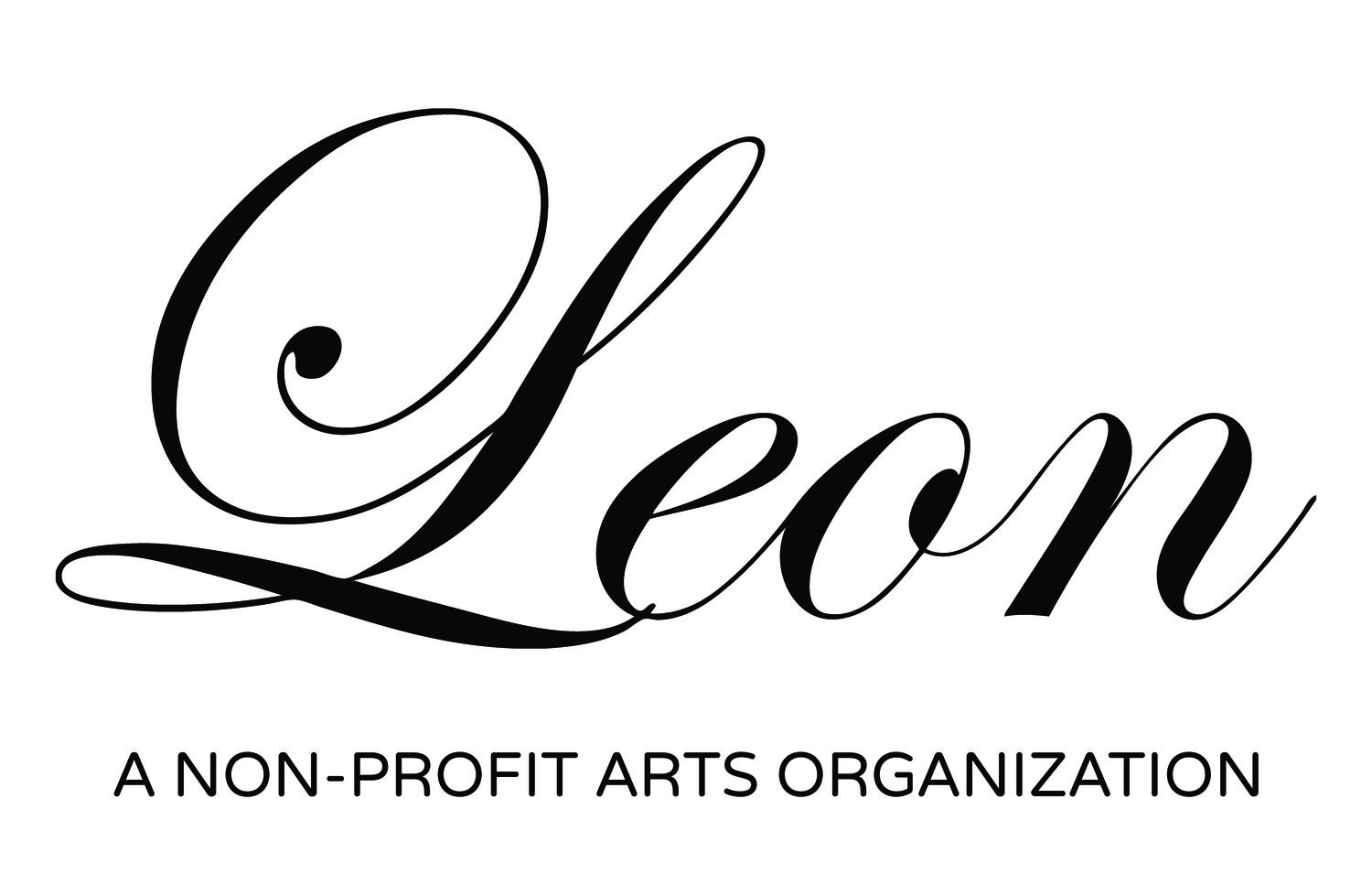From outside Leon Gallery, “Muscle Memory” and “Tya Alisa Anthony” are visible in family album-sized font, hanging neatly on the right side of the entrance wall like the works just beyond them. To the left is a black, three-storied house with green moss clinging to its sides, empty like so many new homes built in Denver and with just the same amount of inefficient room. From the first glance, there is no separation between what is art and what simply is. Above the black house, small, brightly colored buildings, arranged in rows like miniature city blocks, sit perched on shelves inside two golden frames that remind me of my childhood neighborhood in Brooklyn.

Throughout the exhibition, Tya Alisa Anthony shows off her eye for and expertise in multiple mediums. Three portraits hang in the exhibition. One of a Black woman with her back turned, showing off her recently twisted hairstyle. Unaware of being intimately seen, she is sister, aunty, mother, or partner. Another of a Black man, peering out. His features are obscured by design, so he brings us in only as much as he will allow. He is brother, uncle, nephew, cousin, father, or beloved. The last a portrait of two Black women. One is stuntin’ in her bell-bottom pants and a phone in her right hand. The other sports looser pants with a tight top. Like the Black men, their features–hidden behind the design in the foreground–move in and out of focus, save for their smiles. They are twins, cousins, friends, or lovers. On a large wall is a print reminiscent of the wallpaper that adorned grandma’s place, just short of plastic covered couches to complete the living room, although the two leather brown seats atop green grass cut like a rug in the middle of the gallery do just as well. The prints, from afar, look like flowers. Then, upon looking closer, appears the wonderful world of young Black girls jumping rope. They are you, me, daughters, nieces, cousins, and friends. They are what my mom called, smiling in reverence, “the stoop kids.”

On a brick wall are four frames: one with black painted hydrangeas and green moss growing from its corner, one empty exposing just the brick wall, one with black painted hydrangeas and no moss, and one with a cluster of hydrangeas painted black and white. When asked about the use of hydrangeas, Anthony says, “They are clusters of experiences, each petal representing the multiplicity of events, thoughts, processes, and loss.” On a half wall, alone, hangs another frame. But it encloses a shelf of books and below it lies a basket of white hydrangeas. “The gold frames were created by a Black framer in Denver who recently passed away. His family called out to artists in the community to pick up and use the frames,” Anthony says. At the back of the art gallery, almost hiding, is a row of small black buildings in front of the large window that looks out to the alley. Anthony says, “The small sculptures of buildings were made from mat boards and laser etched. I started experimenting [with this medium] in 2019 after I went to Baltimore and found out [the City] was tearing down 15,000 row homes. I rode around with my friends and saw people living in houses with sometimes three vacant homes next to them.” The frames, like the homes in the exhibition and in real life, symbolize value, importance, and permanence in Anthony’s eyes, and now ours.
On a wall to themselves hang five prints of buildings in various stages of dilapidation and new growth, resemblant of parts of Denver’s historic Five Points neighborhood. Angled from the ground up, three buildings, windowless, archless, and doorless, loom like the sculptures outside the Denver Art Museum. One of them, a collection of bricks leaning on each other for support, is slumped at eye level, unflinching and unafraid to fall. The other wears a bright blue tarp like a cape or a flag, either way calling attention. Foliage winds itself in and out of the crevices of the buildings, taking up negative space. I tell Anthony, “A home is a home when someone says it is or when nature fixes itself to live amongst it.” Two large, two-storied Black houses frame the seating area where Anthony sipped on Premye Tea and had 15 minute chats with people from in and around the city of Denver. The interactions among the varying mediums Anthony uses bring to life the many facets of community, family, homes, and city life that most of us could not actively engage with or uphold with each other for over a year.

Tya Alisa Anthony, a Coloradan and Baltimorian, knows how a city breathes, its rich color and complicated history made more complicated by the people who survive to tell its stories. Throughout the pandemic Anthony watched, like most of us, as mom-and-pop businesses across America closed, windows were boarded up, and essential workers returned from work to eviction notices taped to their homes’ doors. “Muscle Memory,” with its prints of aging buildings covered in foliage, frames of painted hydrangeas, sculptures of homes, and portraits of our kin, is the past, present and future, offering us space to mourn and celebrate memory for its power to regenerate movement. Through the lens of a city and its inhabitants, Tya Alisa Anthony’s “Muscle Memory” helps us frame and reframe our foundations and relationships to one another.
Halah Mohammed is a writer and poet from Brooklyn, NYC. Like many other Denver transplants, over the past six years she has taken pleasure in boasting about Colorado’s many wonders, such as the yellow aspen trees, snow-capped mountains, Red Rocks shows, vegan food, and tasty craft beer. When she is not having philosophical conversations with friends, she can be found watching sci-fi and fantasy shows, writing reflections and poetry, working on grad school, and cooking two-course meals (she’s not a baker…yet). You can follow and hang out with her in these spaces: IG: @halahday, @denverreflections, Twitter: @halahday Tumblr: @halahlifeandwords
